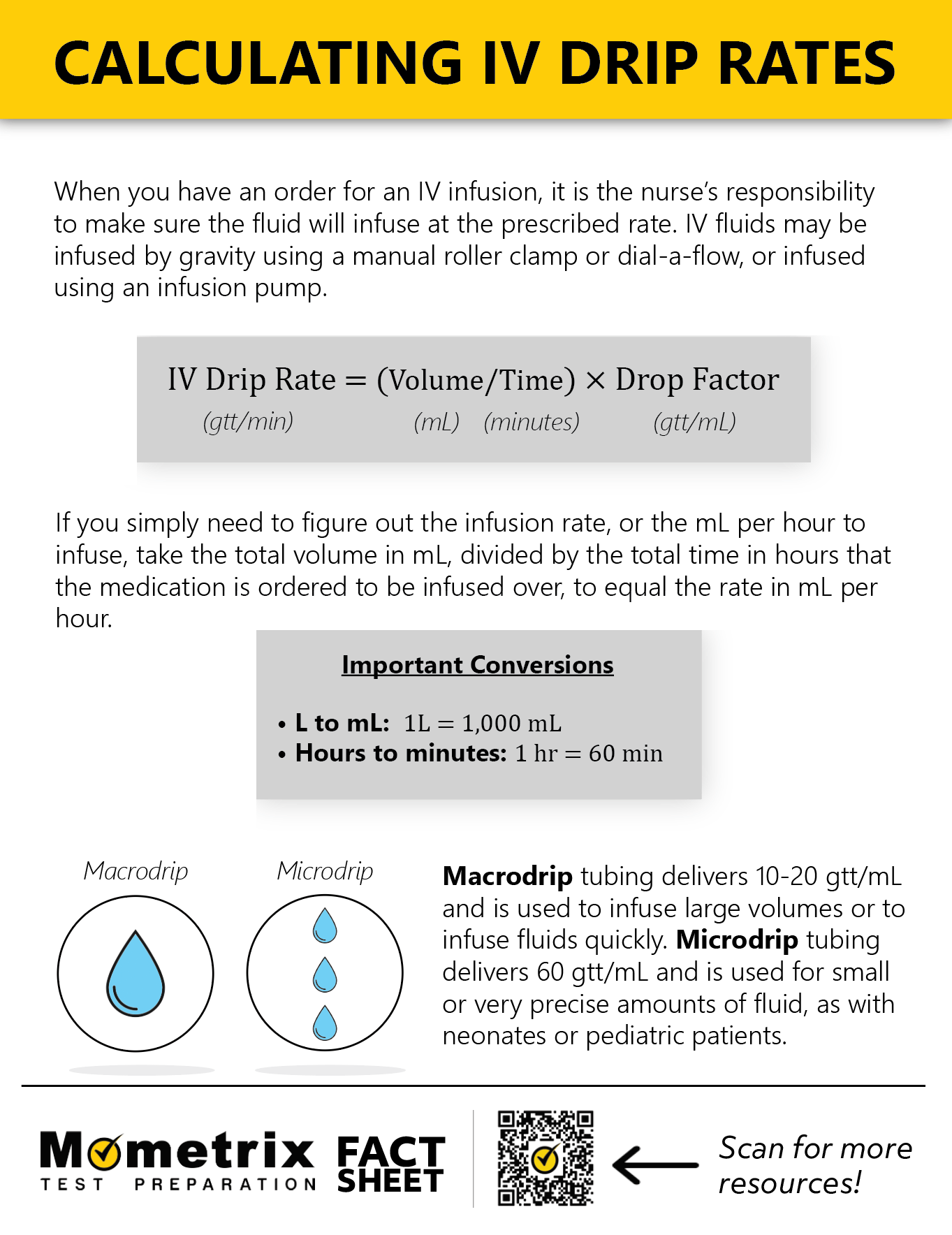what is the flow rate of 1 l of ns to be infused over 8 hours
Calculating Four Drip Rates
Calculator
Welcome to this video tutorial on computing IV drip rates. When you accept an order for an 4 infusion, information technology is the nurse's responsibility to make sure the fluid volition infuse at the prescribed rate. IV fluids may be infused by gravity using a transmission roller clench or dial-a-flow, or infused using an infusion pump.
Microdrip and Macrodrip
Regardless of the method, information technology is important to know how to summate the correct IV flow rate. When computing the menstruum charge per unit, make up one's mind which IV tubing you will be using (microdrip or macrodrip), so yous tin employ the proper drop factor in your calculations. The driblet gene is the number of drops in one mL of solution, and is printed on the IV tubing bundle.
Macrodrip and microdrip refers to the diameter of the needle where the drib enters the drip chamber.

Macrodrip tubing delivers 10 to 20 gtts/mL and is used to infuse large volumes or to infuse fluids quickly. Microdrip tubing delivers 60 gtts/mL and is used for modest or very precise amounts of fluid, as with neonates or pediatric patients.
If you just demand to figure out the mL per hour to infuse, take the full volume in mL, divided past the total time in hours, to equal the mL per hr. For example, if you have one,000 mL NS to infuse over 8 hours, take 1,000 divided by viii, to equal 125 mL/hr. To summate the drops per minute, the drop gene is needed. The formula for calculating the IV flow rate (baste rate) is total volume (in mL) divided by time (in min), multiplied by the drib factor (in gtts/mL), which equals the IV catamenia charge per unit in gtts/min.
Example 1
Allow'southward try an example. The provider has ordered 1,000 mL Lactated Ringers to infuse over 8 hours. Y'all have a macrodrip tubing with a driblet gene of fifteen gtts/mL. Calculate how many gtts/min to set as the Iv flow rate.
Using the formula, 1,000 mL divided by viii times 60 (since nosotros take eight hours times sixty min/hr), and then multiply by 15 gtts/min to equal 31.2, rounded to 31 gtts/min.
Here's a tip: when the Iv tubing is microdrip, lx gtts/mL, the drops per min volition be the same as the mL per hour. For example, you take 500 mL to infuse over 12 hours with a microdrip gear up. The total volume (500 mL) divided by the total time in hours (12) equals 41.6, rounded to 42 mL per hr. The drops per minute would exist calculated equally total volume, divided by fourth dimension (in minutes), multiplied by the drib factor of 60 gtts/min, which as well equals 41.6, rounded to 42 drops per infinitesimal.
Case 2
Let'south expect at an example of an IV piggyback medication.
Ancef 1 gm in 100 mL normal saline to exist infused over thirty minutes. Yous have macrodrip tubing with a driblet factor of 10 gtts/mL. Calculate how many gtts/min to set every bit the 4 flow rate.
Use the formula, with 100 mL divided by thirty min, multiplied by 10 gtts/min, which equals 33.3, rounded to 33 gtts/min. If you demand to set this up on an IV infusion pump, use the formula, book (mL) divided by fourth dimension (min), multiplied by threescore min over 1 hour, this equals the IV flow rate in mL/hour. Using this formula, 100 mL divided past 30 min, times 60 min in i hr, equals 199.9, rounded to 200 mL/hr.
One time the infusion has started, monitor closely to be sure it is infusing at the correct charge per unit and cheque the patient's Four site for signs of infiltration or inflammation.
Thanks for watching this video about calculating 4 baste rates!
Frequently Asked Questions
Q
What is an IV baste rate?
A
An Four drip rate is a mode of describing the charge per unit of an intravenous infusion based on the number of drops (gtt) that are administered to the patient per infinitesimal. This is influenced by the type of the tubing (microdrip or macrodrip), the total volume that is required to be infused, and the time over which the infusion is ordered to run.
Q
What is an IV driblet factor?
A
An 4 drop factor reflects the specific size of the drops of IV fluid that the tubing set creates. This is a predetermined number based on the tubing required and available to administer the medication. Tubing tin be either microdrip or macrodrip.
Q
What is the difference between a microdrip and macrodrip Four tubing?
A
Microdrip IV tubing creates extremely pocket-sized drip sizes for medications that are stiff and must exist carefully administered and/or for patient populations that are highly sensitive to large doses of medications (namely, neonatal and pediatric patients). The microdrip drip factor is generally estimated at threescore gtt/mL.
Macrodrip IV tubing is the more standard tubing type, and has larger drops of fluid than microdrip tubing. The macrodrip drip factor is generally somewhere between 10 to 20 gtt/mL.
Q
How do you calculate an IV drip rate?
A
Iv drip rate is calculated by this elementary formula: IV Drip Charge per unit (gtt/min) = Total Volume (mL)/Time (min) x Drop Factor (gtt/mL)
This equation can also be rearranged to calculate the fourth dimension required for an infusion, when provided the book to be infused, the drip rate, and the drop gene.
Critical to perform prior to completing this formula is any conversions required, such equally fluid volume provided in liters converted to milliliters, or time for infusion provided in hours converted to minutes.
Fact Canvas

Render to Patient Care Videos
396112 278763
Source: https://www.mometrix.com/academy/calculations-of-drip-rates/
Post a Comment for "what is the flow rate of 1 l of ns to be infused over 8 hours"